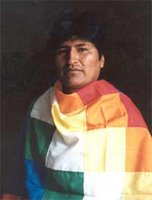La Paz is the world’s highest capital city, at 3,636 meters above sea level. So it is all the more surprising that to get there, you have to descend: it is located is what the locals call a hueco, a hole or a hollow. When I visited in December, I arrived from across the Altiplano, a broad almost perfectly flat plain that stretches out towards Lake Titicaca in the Northwest. Snow-capped mountains loom up on the horizon. The plain itself is dotted with small subsistence farms and apparently run-down huts and houses that gradually coalesce as you approach the city, to form the sprawling shantytown of El Alto.
 With almost a million inhabitants, almost all of whom are migrants from the countryside, El Alto is now a city in its own right and comprises the largest concentration of indigenous people in the Americas. It is here, where the ground is still level, that the international airport is located. And then suddenly, the ground drops away and you find yourself looking down into the hueco itself, a cliff-lined bowl packed with buildings of every type. Five hundred meters beneath you are the sky-scrapers of La Paz city center.
With almost a million inhabitants, almost all of whom are migrants from the countryside, El Alto is now a city in its own right and comprises the largest concentration of indigenous people in the Americas. It is here, where the ground is still level, that the international airport is located. And then suddenly, the ground drops away and you find yourself looking down into the hueco itself, a cliff-lined bowl packed with buildings of every type. Five hundred meters beneath you are the sky-scrapers of La Paz city center.Hunkered down in its hollow, the Bolivian capital shelters from the cold, the wind, and the oxygen-starved air of the high Altiplano. But this relative comfort is won at a price. The motorway that winds down the side of the cliff from El Alto is a precarious affair. And yet almost everything that goes in and out of the city has to pass along it. During the disturbances of October 2004 that ultimately gave rise to the current government of Evo Morales, indigenous protestors took a leaf out of the Argentine piqueteros’ book: they blocked the road, turning their marginal location, perched on the edge of the precipice, into a significant geopolitical advantage. In the narrow and winding city streets far below, it is relatively rare that you get a glimpse of the heights that surround you. But in the tumult leading up to the 2005 presidential elections, the periphery decisively made its presence felt.
Since 2005, and especially in recent months, another periphery has been flexing its muscles. For heading East other routes, among them one labeled the most dangerous road in the world because of the perils of its descent, drop down towards the lowland plains. At well under 3,000 meters, temperate Sucre has long been a counterweight to the constituted power otherwise concentrated in La Paz; a historic colonial center and nineteenth-century capital, it is still the location of the Supreme Court among other government institutions. Further and lower down still, in the sweltering heat where the Andes finally give out and between Amazon basin and Paraguayan desert Chaco, Santa Cruz is now the country’s largest city, a boomtown product of the oil and gas exploration that is the latest key to Bolivia’s dreams of wealth and development, and so also the focus of foreign capital, political machination, and social struggle. If the protests of 2004 and earlier, such as the so-called water war in Cochabamba of 2000 and 2001, almost all took place in the highlands, now it is Sucre and Santa Cruz that are the site of disturbances. At stake is the constitution of the country itself.
Read more... (.pdf document)
Cross-posted to Left Turns?.
